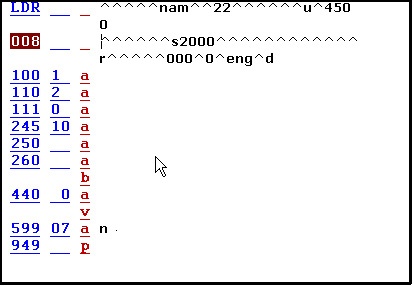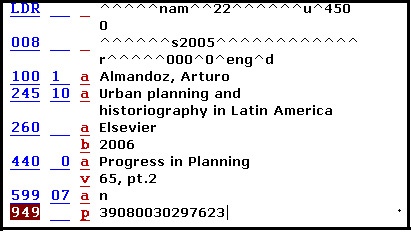Precats Using the precat templateUse the Precat template only if the item has no barcode or wanding the barcode does not bring up a brief record and you have searched WorldCat and found nothing. (See document "Precat via Worldcat search" for details on how to perform a Worldcat search.) Open the PRECT BK.MRC template by doing 'ctrl-a' anywhere in Aleph. Scroll to the bottom of the list to highlight the template name and hit <enter> to open it:  Image Removed Image Removed
Scroll to the bottom of that list and choose 'PRECT BK.MRC'.
<Enter>. --> Template opens:  Image Removed Image Removed If necessary, change date and language in the 008 field by placing the cursor anywhere in the field and doing 'ctrl-f'. The only boxes you need be concerned with are "Type of date" (should be 's' if there is a date on the item and 'n' if not); "Date 1" (the 4 digit year of publication); and "Language". The language codes are ger for German, ita for Italian, fre for French and so on. If you don't know the proper code, go to http://www.loc.gov/marc/languages/langhome.html. If an item contains more than one language, as is often the case with art/ architecture books, the language code is 'mul'.
Hit <enter> when you have completed the 008 modifications and your changes will be acccepted.
If the author of the work is a person, put their name in the 100 field, last name first.
If a corporate author, put the corporate name in the 110 field. And if it is a conference, put the conference title, date and venue in the 111 field. (See samples.) Put the title of the item (taken from the title page, not from the cover) in the 245 field. Publisher, publisher's location, and date go in the 260 field. If the item is part of a numbered series, the series title and volume number go in the
440 field. Fill in the 599 field only if the item is in a non-roman language, entering a three-letter language code after the 'n', leaving a space:  Image Removed Image Removed
(Language codes can be found at: http://www.loc.gov/marc/languages/langhome.htm) Wand the barcode into the 949 field and do 'ctrl-l' to save your new brief record on the server.  Image Removed Image Removed
Now you must create an item record: On the left side of the screen, click the '+' to the left of "MIT50" and then double-click on the word 'ITEMS' that magically appears under it. Now click the 'New' button in the upper left corner and fill in the data boxes in the lower window, under the 'General Information (1)' tab. In the 'Sublibrary' box put the 3 letter code for the library.
'Collection' = PRECT
'Material Type' = BOOK
'Item Status' = 01
(Remove the 'IP' from the Item Process Status box.)
'Call No. Type' = 8
'Call No.' = This part is not so obvious. First, enter '$$h' in the call number box, followed immediately by the 7-digit number that appears at the top of the screen in bright blue, following 'BR System No.'  Image Removed Image Removed
 Image Removed Image Removed Wand the barcode into the appropriate box to complete the process. Creating a Precat record via WorldcatDo an author/title search on WorldCat: - In Search → Find → Advanced Search tab, in the scroll-down list highlight 'Worldcat via Z39.50'. Then enter author and title in the appropriate boxes. <Enter>.
 Image Removed Image Removed
- If the search is successful, push the record to cataloging by clicking the 'Catalog' button.
- In cataloging, click the 'OK' button to accept the 'Brief' option and then do 'Ctrl-n' to duplicate the record, and then click the 'OK' button again to accept the 'MIT Bibliographic' option.
- Hit 'F6' to create a 949 field and wand the barcode:
 Image Removed Image Removed - Immediately do 'ctrl-l' to save the record on the server. This action will create the precat record number which you can then transcribe to the precat flag.
Now you must create an item record: On the left side of the screen, click the '+' to the left of "MIT50" and then double-click on the word 'ITEMS' that magically appears under it. Now click the 'New' button in the upper left corner and fill in the data boxes in the lower window, under the 'General Information (1)' tab. In the 'Sublibrary' box put the 3 letter code for the library.
'Collection' = PRECT
'Material Type' = BOOK
'Item Status' = 01
(Remove the 'IP' from the Item Process Status box.)
'Call No. Type' = 8
'Call No.' = This part is not so obvious. First, enter '$$h' in the call number box, followed immediately by the 7-digit number that appears at the top of the screen in bright blue, following 'BR System No.'  Image Removed Image Removedand Offsite CatalogingWe had recalled all precat materials, and all precat items returned to cataloging were fully cataloged by June 2008. Since then, the backlogs on the WALL have to date been kept under 1,500 items. All rush cataloging requests have been handled in-house with an average 48-hour turn-around time.  Image Removed Image Removed
Wand the barcode into the appropriate box to complete the process.
Non-Roman Precats- To be used when catalogers encounter monographs in non-Roman scripts that cannot be cataloged and must go out as pre-cataloged books.
- This procedure adds an indexed, specially subfielded tag to the brief Barton record.
- The tag makes it possible to re-call precats with specific language characteristics.
Cataloger finds no usable copy for a non-Roman title. Title meets prerequisites for being sent out precat (see Distribution of Incoming Monograph Materials ). Order record exists in Barton. If the cataloger cannot determine the item's language: | Wiki Markup |
|---|
Cataloger edits the Barton order record by adding MARC field 599, with indicators 07 \[zero seven\]. Subfield a contains the text n \[lower case letter N, with no punctuation\]. |
Example: 599 07 a n If the cataloger can determine the item's language: | Wiki Markup |
|---|
Cataloger consults the [MARC Code List for Languages|http://www.loc.gov/marc/languages/langhome.html] .
Cataloger identifies the 3-letter MARC code for the language of the item. Cataloger edits the Barton order record by adding MARC field 599, with indicators 07 \[zero seven\] as above. Subfield a contains the text n \[lower case letter N, with no punctuation\] as above. This is followed by a single space, and the 3-letter MARC code for the language of the item, with no punctuation. |
Example for an item in Arabic:
599 07 a n ara Example for an item in Korean:
599 07 a n kor If the cataloger has no title that can be input in Barton (after checking order record, if there is one), and there has been no Roman-character title provided on gift slip, the cataloger may contact the selector to determine a working title. This title need not be a true transliteration or exact translation. If a title still cannot be determined, a bracketed title such as "Korean title" may be used.
|